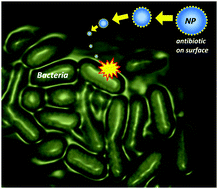Inorganic nanoparticles engineered to attack bacteria
Abstract
Antibiotics were once the golden bullet to constrain infectious bacteria. However, the rapid and continuing emergence of antibiotic resistance (AR) among infectious microbial pathogens has questioned the future utility of antibiotics. This dilemma has recently fueled the marriage of the disparate fields of nanochemistry and antibiotics. Nanoparticles and other types of nanomaterials have been extensively developed for drug delivery to eukaryotic cells. However, bacteria have very different cellular architectures than eukaryotic cells. This review addresses the chemistry of nanoparticle-based antibiotic carriers, and how their technical capabilities are now being re-engineered to attack, kill, but also non-lethally manipulate the physiologies of bacteria. This review also discusses the surface functionalization of inorganic nanoparticles with small ligand molecules, polymers, and charged moieties to achieve drug loading and controllable release.


 Please wait while we load your content...
Please wait while we load your content...